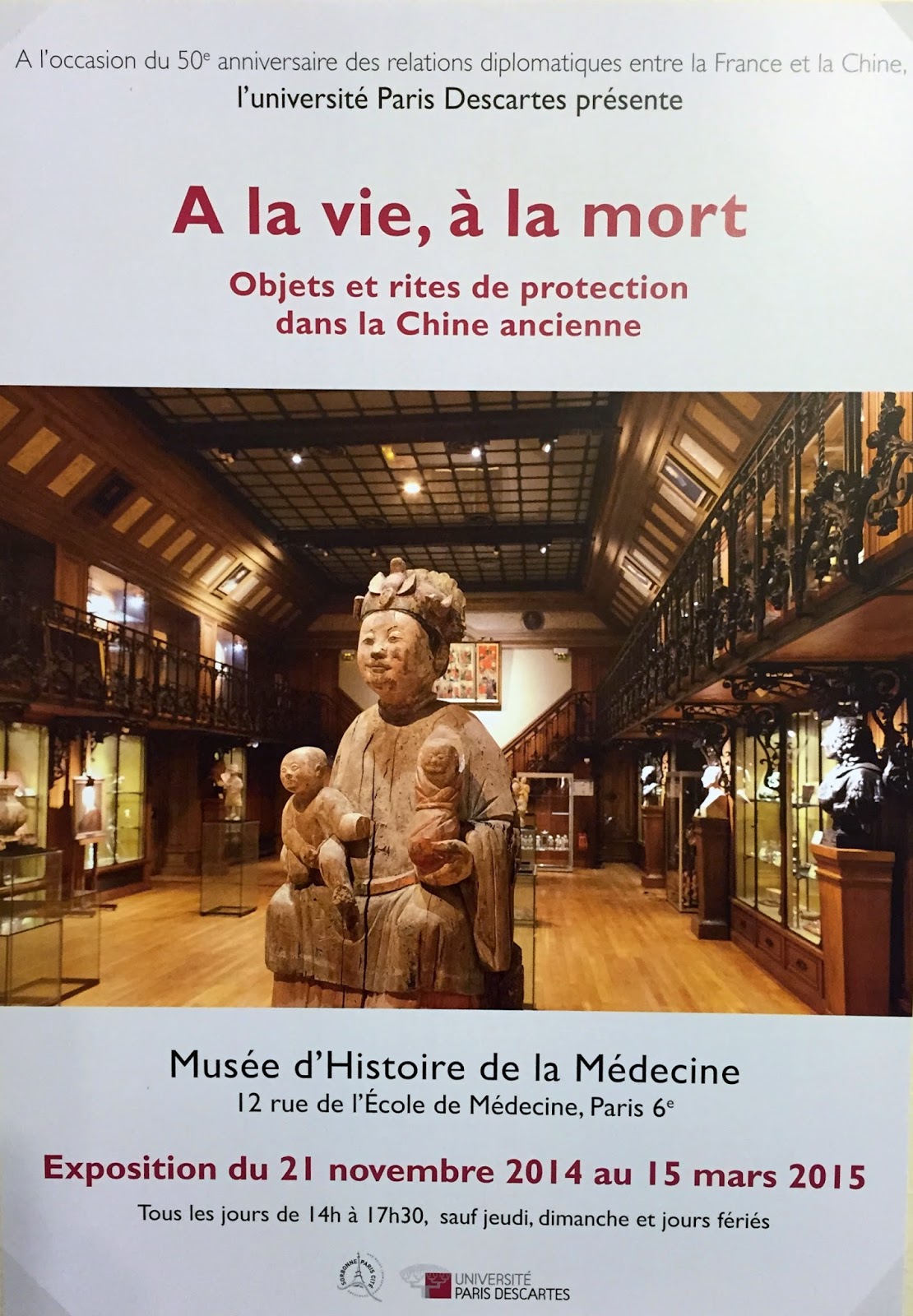
Although I am attracted to most Asian countries, for some reason or another I don’t take much interest in Asiatic art. Of course one should as most of it, especially the little I know of Chinese, Japanese and Korean have histories which even our old Europe doesn’t imbibe in. Walking along the Ecole de Medicine there was a poster for
« Chine, de la Vie à la Mort, Objects and rituals of protection in « old China » » and in the Medical museum which I have never visited.
For a very good reason. Those knifes and descriptions of medieval medicine make me feel faint just to look at them. Read the descriptions and you would undoubtedly find me displayed on the floor horizontally.
 |
| Well, it's another mannequin! |
As in many universities, the place is not indicated very well and after two flights of stairs and not just any stairs but regal and not unalike Versailles, I came upon this.

You must admit that such an opening and presentation of a museum has a lot of charm. Not to mention the sculptures which were intermingled with the medical devices.
 |
| Guanyin - Ming dynasty(1368-1644) |
Protection, whether it be individual or collective has always been a centre point of our civilizations. Perhaps not so much today but the protection of the dead was primordial for the
Confucians, the
Taoists and the
Buddhists, as harmony should continue in the afterlife. The statues I discovered here whether they were domestic or « religious » were fascinating. They were all associated with the buddha but especially the
guanyin (an East Asian deity of mercy, and a bodhisattva associated with compassion as venerated by Mahayana Buddhists
 |
| Guanyin |
 |
| Yue Fei (War and Merchant God (Ming) |
 |
| Yao Wang (God of medicine -1644-1911) |
or bodhisattva (who can be anyone motivated by a real compassion). Rather like guardian angels who were venerated as benefactors of humanity - moving onto the Taoist gods who were overwhelmed with presents so they would cure and preserve us from illness, assure our prosperity, protect us from wars and all blight. I have a couple of Taoist friends and they still believe in their gods.
 |
| Bixia Yuanjun (Princess of azure Skies- Ming) |
Then there are the
mingqi who are there to help the passage from one life to another, which must be like the one we have just left. (Frankly although I have no reason to complain about my life, I would like to cut out certain periods….)
There is this fascinating intermingle between the real and the gods that our ancestors venerated - the New Year in China is something to be lived for that reason. The Buddhists certainly respect and offer gifts to their gods.
 |
| Acrobat design on a vessel (Han Dynasty 206 BC -220 after |
 |
| Fish monger (Han) |
 |
| Woman with a fan (Han) |
 |
| Horseman and horses (Han) |
 |
| Locapala - protector of a grave (Tang dynasty (618-907) |
 |
| Male statues (Han) |
 |
| Lady from the Han dynasty |
 |
| "Doctor from the Han dynasty |
 |
| Civil servant (Tang dynasty (618-90) |
 |
| Bodhisattva in an anti stress position (Yua, Dynasty 1279-1367) |
 |
| Guandi, War God (Qing Dynasty 1644-1911) |
 |
| War God again |
I like the thought though that death is only there to give added value to our lives. Consequently there is a perfect symbioses between life and death. This is made possible by the spirit of our ancestors who are there to guide us during our life on earth and for those who follow them, they are blessed, protected and have an added wisdom. We’d all like that, I think, but do we?
 Although I am attracted to most Asian countries, for some reason or another I don’t take much interest in Asiatic art. Of course one should as most of it, especially the little I know of Chinese, Japanese and Korean have histories which even our old Europe doesn’t imbibe in. Walking along the Ecole de Medicine there was a poster for « Chine, de la Vie à la Mort, Objects and rituals of protection in « old China » » and in the Medical museum which I have never visited.
Although I am attracted to most Asian countries, for some reason or another I don’t take much interest in Asiatic art. Of course one should as most of it, especially the little I know of Chinese, Japanese and Korean have histories which even our old Europe doesn’t imbibe in. Walking along the Ecole de Medicine there was a poster for « Chine, de la Vie à la Mort, Objects and rituals of protection in « old China » » and in the Medical museum which I have never visited.





















Commentaires